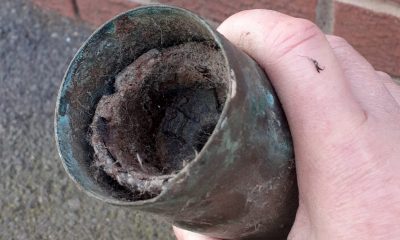Cold sores date back to when Bronze Age people began making out
"Previously, genetic data for herpes only went back to 1925."
Published
2 years ago onBy
Talker NewsBy Mark Waghorn via SWNS
Unsightly cold sores date back 5,000 years to when Bronze Age men and women began making out, according to new research.

The sexually transmitted infection's prehistoric roots have been traced to a cultural practice imported from the east - romantic kissing.
Ancient herpes genomes were mapped after viral DNA was extracted from tooth roots of human skeletons spanning a millennium.
Analysis showed the unsightly, painful lip blisters flourished during the Neolithic period - in the wake of vast migrations into Europe from the Steppe grasslands of Eurasia.
Co-senior author Dr. Christiana Scheib, a research fellow at St. John's College, Cambridge, said: "Every primate species has a form of herpes, so we assume it has been with us since our own species left Africa.
"However, something happened around five thousand years ago that allowed one strain of herpes to overtake all others, possibly an increase in transmissions, which could have been linked to kissing."
Interbreeding triggered population booms across the continent - fuelling rates of transmission.
Co-senior author Dr. Charlotte Houldcroft, from Cambridge's Department of Genetics, explained: "The world has watched COVID-19 mutate at a rapid rate over weeks and months. A virus like herpes evolves on a far grander timescale.
"Facial herpes hides in its host for life and only transmits through oral contact, so mutations occur slowly over centuries and millennia.
"We need to do deep time investigations to understand how DNA viruses like this evolve. Previously, genetic data for herpes only went back to 1925."
The highly contagious herpes simplex virus (HSV), which triggers painful blisters spreads during sex - or even just a kiss.
The researchers point out the earliest known record of kissing is a Bronze Age manuscript from South Asia.
They suggest the custom - far from universal in human cultures - may have traveled westward into Europe from Eurasia.
In fact, centuries later, the Roman Emperor Tiberius tried to ban kissing at official functions to prevent disease spread - a decree that may have been herpes-related.
But for most of human prehistory, HSV-1 transmission would have been 'vertical' - the same strain passing from infected mother to newborn child.
There are two types, HSV 1 and HSV 2, which enter the body through the moist skin of the mouth, penis, vagina or rectum.
Both can cause cold sores on the mouth, genital herpes and small abscesses on the fingers and hands.
It currently infects some 3.7 billion people globally. But ancient examples of the original HSV-1 strain are surprisingly elusive.
This is despite its contemporary prevalence and herpes having a history stretching back millions of years - to forms that infect animals from bats to coral.
The international team hunted down herpes in the remains of four individuals stretching over a thousand-year period.
It often flares up in the mouth. At least two of the ancient cadavers had gum disease and one third smoked tobacco.
The oldest sample came from an Iron Age adult male who lived in Russia's Ural Mountain region around 1,500 years ago.
Two more were local to Cambridge - one from a young female unearthed at a 6-7th century Anglo-Saxon cemetery a few miles south of the city.
The other belonged to a young man from the late 14th century, buried in the grounds of St. John's College, a former medieval hospital. He had appalling dental abscesses.
The final sample came from a young man excavated in Holland - believed killed in a massacre when French troops attacked his village on the banks of the Rhine in 1672.
He was aged around 30 - and was a fervent smoker of clay pipes. Traces are visible in multiple places on the teeth.
Co-lead author Dr. Meriam Guellil, of Tartu University, Finland, said: "We screened ancient DNA samples from around 3,000 archaeological finds and got just four herpes hits."
Herpes is a chronic condition as it can become active after years of lying dormant in the body.
The average outbreak rate is four to five times in the first two years of infection and less frequently afterward.
Co-lead author Dr. Lucy van Dorp, of University College London, said: "By comparing ancient DNA with herpes samples from the 20th century, we were able to analyze the differences and estimate a mutation rate, and consequently a timeline for virus evolution."
Cold sore symptoms can include swollen and irritated gums with sores in and around the mouth, a high temperature, nausea and headaches.
Two-thirds of the global population under the age of 50 now carry HSV-1, according to the World Health Organisation
For most, the occasional lip sores that result are embarrassing and uncomfortable.
But in combination with other ailments – sepsis or even COVID-19, for example - the virus can be fatal. In 2018, two women died of HSV-1 infection in the UK following Caesarean births.
Dr. Houldcroft said: "Only genetic samples that are hundreds or even thousands of years old will allow us to understand how DNA viruses such as herpes and monkeypox, as well as our own immune systems, are adapting in response to each other."
The researchers are now planning to trace the hardy primordial disease even deeper through time, to investigate its infection of early hominins.
Dr. Scheib added: "Neanderthal herpes is my next mountain to climb."
The study was published in the journal Science Advances.
Stories and infographics by ‘Talker Research’ are available to download & ready to use. Stories and videos by ‘Talker News’ are managed by SWNS. To license content for editorial or commercial use and to see the full scope of SWNS content, please email [email protected] or submit an inquiry via our contact form.
You may like


Metals can heal themselves just like ‘The Terminator’


Two-faced star has hydrogen on one side and helium on other


World’s oldest big game hunting weapon found


An espresso a day could keep Alzheimer’s at bay


Being bipolar significantly raises risk of premature death: study


Soccer players who regularly use head more likely to develop Alzheimer’s
Other Stories


New breakthrough treatment boosts cancer-fighting cells
The approach involves activating the immune cells in the body and "reprogramming" them to attack and destroy the cancer cells.


One-year-old can’t stop laughing during first ride at Disneyland
"We didn't expect him to love it that much."


Dad running marathon wearing chainmail weighing over 40 pounds
A dad is attempting to break the world record for the fastest marathon while wearing chainmail.


Hero saves elderly couple by dragging them out of burning car
The Good Samaritan jumped into action after spotting the fire on his way to work.


Bomb squad seals off town after ammunition shell donated to charity shop
Staff discovered the device in a bag of donations.
Top Talkers

 Parenting2 days ago
Parenting2 days agoSingle mom details struggles of feeding her 12 kids

 Broadcast4 days ago
Broadcast4 days agoOver 40% of Americans have no clue what a 401k is

 Broadcast3 days ago
Broadcast3 days agoHow hard is it for Americans to live sustainably?

 Broadcast1 week ago
Broadcast1 week agoGrocery shopping hungry is costing Americans this much

 Funny1 week ago
Funny1 week agoCops confused by crow mimicking police siren

 Shopping1 week ago
Shopping1 week agoGrocery shopping hungry costs Americans this much every trip

 Money4 days ago
Money4 days agoOver 40% of Americans have no clue what a 401k is

 Parenting1 week ago
Parenting1 week agoIt takes this many minutes for the average American kid to get bored
